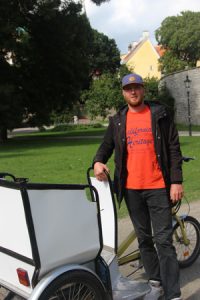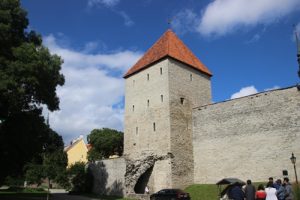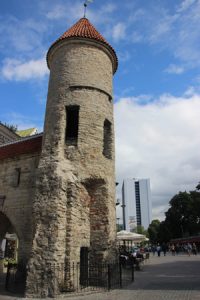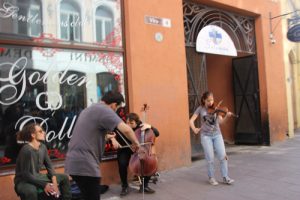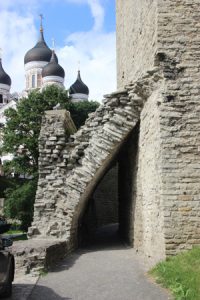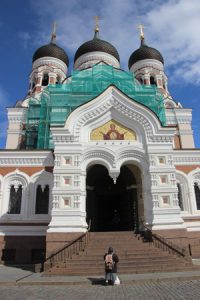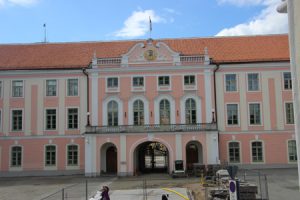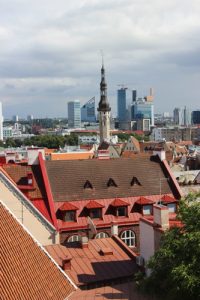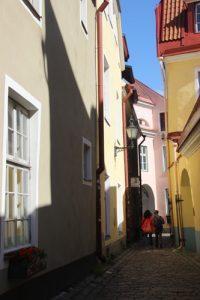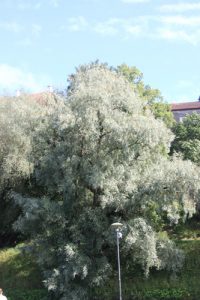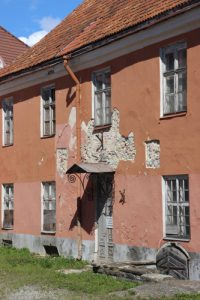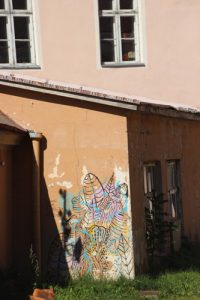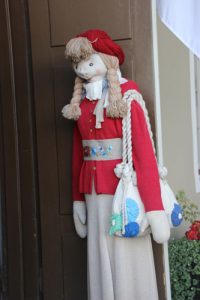(By now you will have figured out that these posts are not in chronological order, but more stream-of-consciousness. Tallinn was a day trip I took before I left for Iceland.)
Meet Sandor.
Sandor is a native Estonian, born in Tartu (a university town). A friend invited him to Tallinn where he could make money driving a pedicab. His friend is now his “ladyfriend” which sounds much nicer than “friend with benefits.”
He was in a line of about eight pedicabs when I walked off the Helinki-Tallinn ferry; a boat which looked, to me, more like a cruise ship than any ferry I’d ever been on. He looked enough like my stepbrother Jay to have convincingly played Jay’s adult son. My stepmother, Faith, spoke mostly about her Scottish heritage, but she was born and grew up in Minnesota and said that half her family was Scandinavian. I felt like I was seeing those roots.
You will see more of Sandor, his arm, in at least one more photo.
Sandor offered me a pedicab tour of the entire city of Tallinn, including modern Tallinn, but I had miscalculated the amount of time I had when I purchased my ferry tickets online. I had less time there than I had hoped.
“Just the Old City,” I said.
Sandor only took Euros, and I hadn’t brought enough with me, but, surprise! He knew the exact location of an ATM and automatic money-changing station. We went there first, obeying traffic lights but weaving in and out between cars, and darting up onto the sidewalks, in a way that I think might not be actually legal, although it’s probably winked at since it’s about tourism. Tallinn, the municipal entity, really likes tourists.
My pedicab ride through the Old City was part historical tour, part Mr. Toad’s Wild Ride.
Taillin became a city in or around 1248. An earlier name for the city was Reval. Reval was a major economic power in the succeeding centuries, especially once it affiliated itself with the powerful coalition of trade and merchant cities called the Hansa or the Hanseatic League.
The city sits atop a hill overlooking the harbor. It was a walled city, and the walls still stand (or have been restored) throughout the town. One half of the pair of pillars that supported the harbor-side gate still stands.
“Can I take your picture with your cab?”
“Yes,” he said.
“Do all your passengers ask that?”
“Yes,” he said.
Beyond the gate pillar is a flower market. Sandor zoomed through it before I could think to get photos (the two I snapped were hopelessly blurry) and before I could gather my wits to ask him to go back. As it was, we shot through the small crowd gathered around these musicians, and I got a good photo of them.
“Why are you taking picture of that?” he said.
“Because of the shape, and the rock border.”
“What about those shapes?” he said pointing at the onion spires of the Russian Orthodox cathedral that rise right behind this covered walkway.
The cathedral is still in use as a church, and no interior photographs are allowed of its glowing golden beauty. Signs posted in several languages request quiet, but that was mostly being ignored. The interior was lit with both electrical light and beeswax candles, which pelted the gold leaf around the icons and on the altar railing with buttery light. Sandor went outside to take a phone call.
Across the street from the cathedral is a long pink and white building used by the Estonian parliament. They were doing work on the parking lot and the fence.
“I don’t feel good when I am in cathedral,” said Sandor. “Maybe because it is Russian.”
“Maybe you’re allergic to beeswax.”

This is the Old City Square. Sandor said they had trials there in the old days “and probably hanged people.”
The relatively new name of Tallinn/Tallinna may mean “Danish town,” dating from when Estonia was under Danish rule, or perhaps, “winter town.”
Sandor does not like the county of Russia. “Russia is angry, violent country,” he said. I couldn’t really argue with that statement.
Later, after the cathedral remark, Sandor began to talk about Russians who live in Estonia. He didn’t like them much, either.
Tallinn had not had a good summer according to him. “All the time it rains,” he said. “And now—you see there? Leaves on ground?” He pointed to a scrim of dried, scrolled-up leaves at the edge of the path. “Already leaves are falling and autumn comes.” This short, cool summer had made an impact on the tourist trade, and that meant that Sandor had not had a good summer either. In a good year, he said, he makes $200-500 Euros in a day (that is quite a range.) This year he was struggling to make $200, which was his “floor.” He was not happy about this.
He stopped in front of a gift shop that featured Baltic amber. Lots of shops in the Old City feature Baltic amber. He pointed to a Tiffany-style desk lamp, a mosaic of gold, orange, cream and tortoise-shell lozenges of fossilized tree-sap. “You buy that lamp? Only 4,000 Euros.”
“I can’t fit it in my luggage.”
The shop owner, who had, coincidentally, just stepped outside, said, “We can post.”
He wheeled us up to one of the three best lookout points. The views flow downward, red roofs through green leaves, all the way down to the water.
Sandor did not care for people who were born in Estonia but were ethnically Russian, either. We stopped at an exterior booth where I bought some flavored almonds from a blond woman. Her English was not as good as Sandor’s, something he pointed out as he pedaled us away. “You notice? Her English? She is Russian. They don’t like to learn English. They like to stay with themselves.”
This made me sad for a couple of reasons. This sounded like nationalism—or bigotry. This particular Sunday, while I was riding through the Old City in Estonia, was the weekend of the neo-Nazi riot in Charlottesville, North Carolina. (At the time I was talking to Sandor I did not know that a white-supremacist terrorist had killed a woman there.) Russia occupied Estonia; the relationship seems difficult. Still, hearing him use the same types of generalizations one hears about any ethnic group that isn’t yours saddened me.
It also worried me a little. Putin invaded Ukraine using in part the pretext that “ethnic Russians” in Ukraine were being badly treated and “asked for help.” I could picture a similar situation in Estonia, especially if it continues to grow as a tech-power.
I don’t know what it’s like for ethnically Russian Estonians. Are they seen as outsiders? Sandor certainly talked about them that way.
The walls, still, mostly circle the Old City.
Sandor showed me the narrowest street in Tallinn. Certainly, if fifteenth century nobility came riding through on their horses, people either stayed inside or climbed up out of the way. There was no “share the road” vibe going on.
“This is Deer Park. Very nice park,” he said. “This is place where people come and can say whatever they want. Free speech. They can say anything. Complain about government. Read poetry.”
We rode for a while. He raised his left hand and pointed across the street. “There is my garage,” he said.
“Is this still part of the nice park?”
“Yes,” he said, and veered off the pavement onto the crushed-stone path, particles flying left and right, pigeons squawking and waddling out of the way (although he wasn’t going fast enough to spook them into flight). “That is very beautiful tree,” he said. “It grows by water. It is silver birch, I think, but I am not tree scientist, so don’t quote me.”
(It is a silver birch.)
Estonia has a lot of trees and sells a lot of lumber, he told me.
What kinds of trees?
“Pine trees, birch,” he said. He pedaled. “Oak. We have oak trees. Chestnut trees.”
“We have hardly any chestnut trees left in the US,” I said.
“We will sell you some.”
(It turns out chestnut trees are not plentiful in Estonia. Pine, spruce and birch seem to be the big sellers as far as exports go.)
“Why are you taking that picture?”
“It’s interesting.”
“I have people once, they only photograph small,” he said. “I show them beautiful lookout, they say, ‘Oh, look at this rock!’”
“That sounds like it would be me.”
“I show them church, beautiful church, they say, ‘Oh, look at window frame!’”
“That’s exactly like me,” I said as I took a picture of some graffiti.
“What’s with those figures, the dolls?” I said. These showed up in several places, like mannequins, but with soft bodies, made of cloth, probably stuffed with batting.
“They show off traditional Estonian clothes.”
He got me back to the harbor with fifteen minutes to spare, and even though tipping was not encouraged in any of the countries I visited, I paid him 90 Euros instead of the 80 we’d agreed to. He didn’t say no.
A brisk pedicab ride was not what I had been expecting. As a plan for a photo safari, I don’t recommend this. Or, I would recommend it, if you explain to your cabbie that you are going to want to make stops at random. (I was worried about the amount of time I had.) As an experience in a city that was new to me, Sandor’s wild ride was wonderful.
I waved good-bye and got back on the Viking mini-cruise ship, and headed back to Helsinki.

